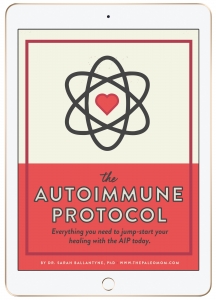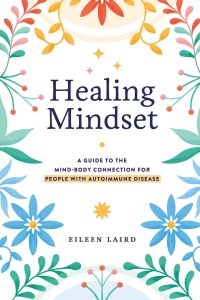“Strict” AIP is NOT a Life-Sentence
The AIP is meant to be approached in stages – elimination, maintenance and reintroduction. Unfortunately, reintroducing foods often intimidates people because they fear either the process or the potential reactions, and they get STUCK … stuck on the STRICT AIP elimination stage for too long, which is not healthy for body or mind. On the flip side some are too impatient and try to add foods back in too quickly making their efforts futile.
By now I hope you’ve read up on the AIP and understand the three stages to the dietary process. If not, please go back to step #1 and be sure to get a good grasp of it all.
To re-cap, the reintroduction stage is where the real food-trials come in. You’ve removed the most commonly reactive foods from your diet, and now you’ll be adding them back in, sloooooowly, in a specific order (most nutrient dense options first) one at a time to determine if you are reactive to any of them.
So … when can you get started?
It’s Personal
I know I’ve said this a few times but the AIP is meant to be a template, it’s a very personal protocol and eating plan and so too goes the topic of reintroductions. For some, a minimum 30 day of elimination stage is fine, for others it might take 60 or 90 days or much longer, but it’s really not as bad as it sounds. Bottom line, there’s no one right answer for everyone … it’s personal!
Typically, Functional Medicine Practitioners recommend not starting the reintroduction phase until you’re “symptom free” (or have seen some significant improvements) … and obviously this varies by person and condition.
Your body needs time to “rest and digest” … “recover and repair” … basically, you need to be in an un-inflamed state before you try reintroducing foods, otherwise you may never really know what you’re sensitivities are.
To put timing in perspective, because I know you REALLY want to know how long you’re into this for, think of it this way … you didn’t get sick over night, your digestive and immune system didn’t take one hit that caused them to fritz! For many, it’s likely that your body has been taking some abuse in the form of poor eating and drinking habits, toxic exposures or poor lifestyle habits for a while and it’s just been a long slippery slope into your current state of dis-ease. Realistically then it’s going to take some time to un-do those things, bring inflammation down and improve your gut function. Thankfully our bodies are miraculous and can heal if we give them the tools for the job.
If you’re struggling after 30, 60 or 90 days and feel you should be ready, step back and look at your situation honestly. Have you addressed all of the other areas of the AIP as well? Stress, exercise/gentle movement and environmental toxins are a couple that can play a huge role in your recovery, and if you’ve been avoiding addressing these, they may well be what’s stalling your progress. Beyond this there are other factors to consider too and you may want to consider this article on Troubleshooting the AIP.
IMPORTANT NOTE – if you’re still not seeing improvement after 90 days of giving the full Autoimmune Protocol a chance, please seek the advice of an expert to help you dig deeper to find your root cause – there is likely something else holding you back from healing that may not be obvious – click here to find a professional near you.
Be Patient
Some may want to rush into reintros, but remember … slow and steady wins the AIP Race!
Resist the urge to start too soon and resist the urge to wing it when it comes to reintroductions. You’ve put in 30-90 days (or maybe even more) on the elimination stage, don’t waste that effort by throwing in the towel or choosing to decide for yourself how best to reintroduce foods.
The elimination stage was meant to heal your body, and if you’ve been patient and are really feel quite well, reintroductions will likely be an easy process for you. Starting with a “clean slate” so to speak will allow your body to speak to you when you’ve reintroduced something that is not agreeing with you.
That said, be sure to follow a systematic plan of reintroduction when the time comes, including keeping a food and symptom journal (more about that in the resources below).
So, how do you get started? Following are the guides and resources I recommend you consider for best results.
Keep Moving!
What ever you do, keep moving forward – there are no rewards for longest amount of time on the AIP elimination stage!
I’m always shocked and stunned when I hear people in my AIP Recipe Collection Facebook Group proudly comment that they’ve been strict AIP elimination for 759 days or “x” number of months or years! No, no, no, no!! This simply can’t be!
I mean, I get it, there are a lot of folks out there who simply feel too darn good after having eliminated the top inflammatory offenders from their lives that they don’t want to go back to feeling horrible again. But this is where food fear creeps in, and ultimately why we find people out there touting that “the AIP is a dangerous, restrictive diet that just keeps people sick.”
Let’s be clear, elimination diets and the reintroduction process is still considered to be the gold standard in assessing food allergies and sensitivities – even more so than largely inaccurate food sensitivity / allergy testing (you can read more about that here if you’re wondering about that statement). The elimination phase gives the body time to calm and heal, BUT it is NOT meant to be long-term, that is NOT the goal of the Autoimmune Protocol! The magic starts to happen when we begin reintroductions and strive for nutrient density and variety in our diet. This is when we start accumulating personal data and identify what’s potentially driving our symptoms.
Beyond that, reintroductions are just practical! They help improve our quality of life and open up our ability to socialize more freely. No one wants you to get stuck on a restricted diet – it’s hard to maintain – but more importantly we don’t want to get stuck in long-term restriction because it could cause more harm than the good you’ve seen it do.
Don’t be a case that perpetuates the myths and misconceptions about this protocol – keep moving!
If you remember, back at the beginning when we started talking about what the AIP is, what we’d eat and what we’d avoid, we specifically said there were some very nutritious foods that would be eliminated – TEMPORARILY! In short, limiting and restricting food groups long-term can cause dysbiosis in the gut and nutritional deficiencies, so we need to get those back into our diets as soon as possible if they’re not problematic to our individual case.
That said, I hope you see how important it is that you MUST put on your big people pants and take on reintroductions. You’ve already proven that you can do hard things by making it this far, reintros are just the next step – and you’ve got this!
Reintroduction Guides & Resources:
Reintroductions can be tricky, but like I said, you can do hard things. It’s always tempting to try to compare your reactions with someone else’s, but the bottom line is that this too is VERY individual. You will need to keep good track as you go along so you can recognize signs and symptoms of reactions and celebrate all the wins along the way.
As always, my number one, go-to resource for ALL stages of the AIP, is – The Autoimmune Protocol ebook – Dr. Sarah Ballantyne
As of June 2021, the first cookbook dedicated to AIP reintroductions was released, and it’s spectacular! It’s great for all stages of the AIP and a great motivator. It discusses the process of reintros and provides delicious recipes to keep you progressing – check out my review here – The Autoimmune Protocol Reintroduction Cookbook – Kate Jay of Healing Family Eats
More articles from my favorite, reliable AIP Experts:
Definitive Guide To Reintroductions – Autoimmune Wellness
Personalized AIP – Autoimmune Wellness
Reintroducing Foods After Following the AIP Elimination Stage – The Paleo Mom
Updates to the Autoimmune Protocol – The Paleo Mom
Top 5 Mistakes People Make Reintroducing Foods – Eileen Baird
Why Aren’t My AIP Reintroductions Working?

 Where to Begin?
Where to Begin?


 Another amazing resource that I highly recommend you check out is the book by Eileen Laird called “Healing Mindset.”
Another amazing resource that I highly recommend you check out is the book by Eileen Laird called “Healing Mindset.”